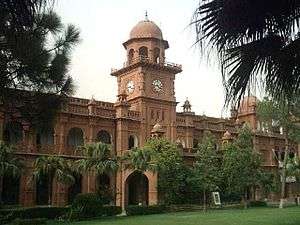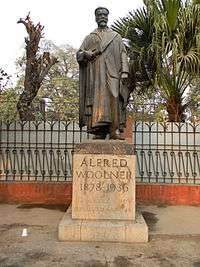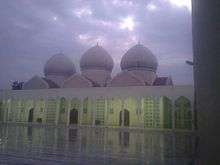University of the Punjab
.svg.png) | |
| Motto |
Urdu: ایمان ، اتحاد ، تنظیم (Iman, Ittehad, Tanzeem) |
|---|---|
Motto in English | Faith, Unity, Discipline |
| Type | Public |
| Established | 1882[1] |
| Chancellor | Malik Muhammad Rafique Rajwana |
| Vice-Chancellor | Mujahid Kamran |
Academic staff | 730[1] |
| Students | 45,000 (on campus), 331796 (off campus)[2] |
| Location |
Lahore, Gujranwala, Khanspur, Jhelum Total are 2200 acer, Punjab, |
| Campus | Urban |
| Colours | Blue, Bronze, Red |
| Nickname | PU Lahore |
| Mascot | Pioneer |
| Affiliations | Higher Education Commission of Pakistan, Pakistan Engineering Council |
| Website |
pu |
The University of the Punjab or Punjab University (Urdu: جامعہ پنجاب), is a public research university located in the downtown Lahore, Punjab, Pakistan.
It is the oldest and largest public university in Pakistan.[1] With multiple campuses in Gujranwala, Jhelum, and Khanspur, the university was formally established by the British Government after convening the first meeting for establishing higher education institutions in October 1882 at Simla.[3] The Punjab University was the fourth university to be established by the British colonial authorities in the indian subcontinent; the first three universities were established in other parts of British India.[4][5]
Approximately 30,000[1] enrolled students are currently attending the university, the PU has total of 13 faculties within which there are 63 academic departments, research centers, and institutes.[1] The Punjab University has ranked first amongst large-sized multiple faculty universities by the HEC in 2012.[6] There are also two Nobel Laureates amongst the university's alumni and former staff.[1] Additionally, the university is also a member of Association of Commonwealth Universities of the United Kingdom.[7]
History
The University of the Punjab was given its initial impetus by Wood's despatch in 1854. Gottlieb Wilhelm Leitner was the founder of the university. Contrary to the three previously established universities, which were only examining institutions, the University of the Punjab was both teaching as well as examining body right from the beginning.
From its formation in 1882 until 1947, the University of the Punjab served the educational needs of the entire region of pre-independence Punjab and northern India. Mohindra College, Patiala was the first college of higher learning to affiliate with University of Punjab in 1882; followed by St. Stephen's College, Delhi. The independence of Pakistan in 1947 reduced the geographical jurisdiction of the university, as it was split into two separate universities in the respective countries. The Indian portion of the university is referred to as Panjab University, Chandigarh, India. The current Institute of Administrative Sciences was created in 1962.
Many major institutions that were previously affiliated to Punjab University have now become independent universities on their own, such as Government College University, Lahore and Medical and Engineering Colleges. [8]
Campus

The University of the Punjab is divided into several campuses across Punjab with one summer campus located in Khyber Pakhtunkhwa:[3]
- Allama Iqbal Campus: also known as the old campus, located in the centre of Lahore, it is named after the great South Asian thinker and mystic poet Allama Muhammad Iqbal. The campus houses the Senate, the Syndicate, the Selection Board and the Advanced Studies & Research Board are generally held there.[9]
- Quaid-i-Azam Campus: also known as the new campus, it is named after the founder of Pakistan and is located 12 kilometres (7.5 mi) to the south of the Allama Iqbal Campus. Spread over an area of 1,700 acres (7 km2) of lush green landscape this campus is the centre of academic and administrative activities of the university. A canal divides the academic blocks from the student lodgings.[10]
- Gujranwala Campus: the faculties of Commerce, Economics and Management Sciences, Law and Science all conduct teaching in the campus.[11]
- Khanspur Campus: the summer campus is located at a height of about 7,000 ft (2,100 m) in the Himalayan range near Ayubia. This campus, in addition to providing research facilities, is also used as a recreational center for the faculty and the students.
- Jhelum Campus: having recently opened in 2012, it offers studies relating to the faculties of Commerce, Economics and Management Sciences, Law and Science.[12]
Residence Halls
At present PU has 28 dorms 17 for male and 11 for female students. Most of these students are accommodated in the dorms at the Quaid-e-Azam Campus. Total number of hostel residents is 6961.
On-campus housing facilities include 89 houses for teachers and University officers and 249 houses for junior staff of the University. About forty houses and eighty single accommodations are available in the various student hostels that are occupied by Wardens, Superintendents and Assistant Superintendents. The University plans to build more houses for the academic faculty and other employees. A bachelor teacher's hostel provides accommodation to the younger members of the academic staff. A guesthouse within the Residential Colony and the guestrooms in the Student-Teacher Center provide accommodation to the academics visiting the University. [13]
Academics

Faculties
There are 13 faculties in the University with 10 constituent colleges, over 73 departments, centres, and institutes. It has over 808 permanent faculty members involved in teaching/research and over 36,000 on campus students.:[14]
- Faculty of Arts and Humanities
- Faculty of Information Technology
- Faculty of Behavioral and Social Sciences
- Faculty of Commerce
- Faculty of Economics and Management Sciences
- Faculty of Education
- Faculty of Engineering & Technology
- College of Engineering & Emerging Technologies (CEET)
- Faculty of Islamic Studies
- Faculty of Law
- Faculty of Life-Sciences
- Faculty of Medicine & Dentistry
- Faculty of Oriental Learning
- Faculty of Pharmacy
- Faculty of Science
- Faculty of Mosques

Constituent Colleges
- Hailey College of Banking & Finance
- Hailey College of Commerce
- University College of Pharmacy
- Punjab University Law College
- Punjab University College of Information Technology
- College of Arts and Designing
- College of Engineering & Emerging Technologies
Research and collaborations
The university has collaborated with different universities globally and has articulation agreements with the College of Agriculture and Life Sciences of Cornell University and San José State University in the United States. It also has agreements with the University of Manchester, University of Luton, University of Bedfordshire, University of Birmingham, University of Surrey, University of Bradford, University of Cambridge, University of Derby, and University of Glasgow in the United Kingdom. In China, Punjab University has collaborations with Beijing University of Chemical Technology, City University of Hong Kong, Wuhan University School of Foreign Languages and Literature, University People’s Republic of China, Sichuan University, and Zhengzhou Medical University and in Iran with Markaz Nashr-e-Miras-e-Maktoob, Ferdowsi University of Mashhad, University of Tehran, and Tarbiat Modares University.
Punjab University Library
Punjab University Library is one of the largest libraries among the universities of Pakistan. The library has more than 500,000 collection of books, magazines and periodicals. This collection is in nine different national and international languages and different types as print material, CDs, DVDs, Microfilms, Microfiches, Video and Audio Cassettes and Manuscripts. Punjab University Library has beautiful two-storey building and total area of the building is 102,000 sq. feet. There are reading halls in both ground and 1st floor with approximately seating capacity of 2500 readers. The library has internet lab for the students to research according to the new technologies of 21st century. In the library there is computerised "MLIMs" catalogue for searching material.[15]
Notable alumni
University of the Punjab alumni include two Nobel Laureates, Har Gobind Khorana (1968 - Medicine), and Abdus Salam (1979 - Physics). Other famous alumni are Satish Dhawan(ISRO), nuclear physicist Ishfaq Ahmad, Choudhry Rahmat Ali, human rights activist Asma Jahangir, poet and mystic Omer Tarin, relativistic astrophysicist and cosmologist Muhammad Sharif (cosmologist) and others .
See also
- Center for Applied and Molecular Biology
- Ilmkidunya Academics related information for Punjab University
- Muhammad Sharif (cosmologist)
References
- 1 2 3 4 5 6 "Introduction". University of Punjab. Retrieved 26 May 2013.
- ↑ "Fact Books" (PDF).
- 1 2 "PU campuses". University of the Punjab. Retrieved 26 May 2013.
- ↑ "A History of the University of the Panjab". World Digital Library. Retrieved 26 May 2013.
- ↑ "Affiliation". PU. Retrieved 9 September 2013.
- ↑ "HEC Pakistan Rankings by research quality". Higher Education Commission of Pakistan. Retrieved 26 May 2013.
- ↑ "ACU members". ACU Members,. Retrieved 9 September 2013.
- ↑ "Educationist".
- ↑ "Allama Iqbal Campus". University of the Punjab. Retrieved 22 November 2012.
- ↑ "Quaid-i-Azam Campus". University of the Punjab. Retrieved 22 November 2012.
- ↑ "Gujranwala Campus". University of the Punjab. Retrieved 22 November 2012.
- ↑ "Jhelum Campus". University of the Punjab. Retrieved 22 November 2012.
- ↑ "Hostels". University of the Punjab. Retrieved 2013-03-20.
- ↑ "University of the Punjab official website". Pu.edu.pk. Retrieved 2012-11-01.
- ↑ "Punjab University Library – History and Introduction". Pulibrary.edu.pk. Retrieved 2011-10-23.
| Wikimedia Commons has media related to Punjab University, Lahore. |
Coordinates: 31°17′34″N 74°10′29″E / 31.29278°N 74.17472°E